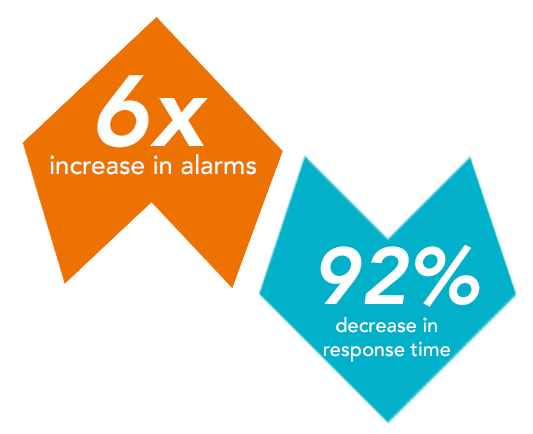#manage growth and complexity
Global technology company
decreases response time by 92%
#manage growth and complexity
CASE STUDY: At-a-Glance
 Challenge
Challenge
The customer was experiencing rapid business growth and over a 3-year period planned to increase their worldwide locations by 60% —to over 400 sites globally. Their goal was to standardize their international operations using economies of scale to improve security response and performance. Their operational challenge was to deploy a new, universal response interface across all regions–as alarm traffic from new sites continued to grow rapidly. At the same time, their IT challenge was to deploy a system that could easily scale with business growth and leverage the interconnection between regions to build a more robust, high-availability infrastructure.
Management defined success as:
- To deliver dramatic service level response improvements through automation
- To provide standardized processes and better communication within the security team, empowering the staff to deliver improved outcomes faster
- To connect the field operations teams to the centralized command centers to creating ‘one team’
 Industry
Industry
Global Technology Company
 Products
Products
- SureView Enterprise
- SureView Field Operations
- SureView Mobile
- SureView Cases
- Integrated Systems
- 10 custom integrations with existing security/business systems
- Enterprise Access Control System
- Enterprise Video Management System
CASE STUDY: At-a-Glance
 Industry
Industry
Global Technology Company
 Products
Products
- SureView Enterprise
- SureView Field Operations
- SureView Mobile
- SureView Cases
- Integrated Systems
- 10 custom integrations with existing security/business systems
- Enterprise Access Control System
- Enterprise Video Management System
 Challenge
Challenge
The customer was experiencing rapid business growth and over a 3-year period planned to increase their worldwide locations by 60% —to over 400 sites globally. Their goal was to standardize their international operations using economies of scale to improve security response and performance. Their operational challenge was to deploy a new, universal response interface across all regions–as alarm traffic from new sites continued to grow rapidly. At the same time, their IT challenge was to deploy a system that could easily scale with business growth and leverage the interconnection between regions to build a more robust, high-availability infrastructure.
Management defined success as:
- To deliver dramatic service level response improvements through automation
- To provide standardized processes and better communication within the security team, empowering the staff to deliver improved outcomes faster
- To connect the field operations teams to the centralized command centers to creating ‘one team’
 Solution
Solution
In order to deliver a project with such aggressive goals and a large and diverse scope, the SureView project teams developed an approach focused on refining the program locally at the largest campus then replicating this model across the organization.
The first step was to identify key users at the local campus who could provide early operational feedback and expert direction on developing the procedures to hit their aggressive SLA targets. Making them part of the project was key to project buy-in and would later be crucial as these “power users” helped champion the project and support training programs as it rolled-out through new regions.
Administrators and security technology teams developed runbooks to document how new buildings, users, assets, and systems would be added. Again, the focus was on refining the steps so that anyone in the team could later use this as a simple step-by-step guide for onboarding.
Together with the IT team, a deployment plan was developed to allow the system to scale globally using a federated architecture. System resilience was an important goal—any region needed the capability to seamlessly take over monitoring of another region. Once deployed the operations team and IT team used unscheduled “storm testing” (a disaster recovery rehearsal to test the loss of a center) to validate the resilience of the infrastructure and help build confidence in the system.
Once all of these processes and systems had been tested and refined locally the project was expanded, first regionally, then nationally, and ultimately globally.
 Solution
Solution
In order to deliver a project with such aggressive goals and a large and diverse scope, the SureView project teams developed an approach focused on refining the program locally at the largest campus then replicating this model across the organization.
The first step was to identify key users at the local campus who could provide early operational feedback and expert direction on developing the procedures to hit their aggressive SLA targets. Making them part of the project was key to project buy-in and would later be crucial as these “power users” helped champion the project and support training programs as it rolled-out through new regions.
Administrators and security technology teams developed runbooks to document how new buildings, users, assets, and systems would be added. Again, the focus was on refining the steps so that anyone in the team could later use this as a simple step-by-step guide for onboarding.
Together with the IT team, a deployment plan was developed to allow the system to scale globally using a federated architecture. System resilience was an important goal—any region needed the capability to seamlessly take over monitoring of another region. Once deployed the operations team and IT team used unscheduled “storm testing” (a disaster recovery rehearsal to test the loss of a center) to validate the resilience of the infrastructure and help build confidence in the system.
Once all of these processes and systems had been tested and refined locally the project was expanded, first regionally, then nationally, and ultimately globally.
 Results
Results
- As the operation was expanded from local, to regional, national and then global, the alarm traffic handled by the same team increased 6 times
- Yet, the team became more efficient, with response time (the time taken to acknowledge an alarm) falling from an average of 14 minutes to just 90 seconds
- And, a vastly Improved Service Level (SLA) was established for dispatch (the time to dispatch a field operative when needed). This was reduced from an average of 3.5 minutes to 28 seconds
- A reduction in projected overall operating cost was realised as no new security centers were required to accommodate the monitoring of new locations
- The resilience of the system is tested quarterly by conducting unscheduled “storm tests” —no operational downtime has been experienced during these sessions
- With new features and functions added bi-weekly, the velocity of updates has increased. A managed, pipeline update process has negated the need for scheduled maintenance windows, ensuring operational availability


 Results
Results
- As the operation was expanded from local, to regional, national and then global, the alarm traffic handled by the same team increased 6 times
- Yet, the team became more efficient, with response time (the time taken to acknowledge an alarm) falling from an average of 14 minutes to just 90 seconds
- And, a vastly Improved Service Level (SLA) was established for dispatch (the time to dispatch a field operative when needed). This was reduced from an average of 3.5 minutes to 28 seconds
- A reduction in projected overall operating cost was realised as no new security centers were required to accommodate the monitoring of new locations
- The resilience of the system is tested quarterly by conducting unscheduled “storm tests” —no operational downtime has been experienced during these sessions
- With new features and functions added bi-weekly, the velocity of updates has increased. A managed, pipeline update process has negated the need for scheduled maintenance windows, ensuring operational availability

Learn More?
Want to learn more about what we do? Speak with an engineer? Schedule a demo? Coordinate a reference call? Please enter your contact details then choose from the drop down list.



